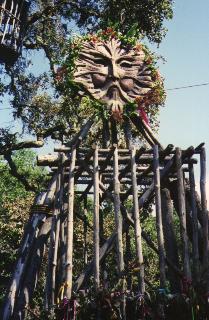 Beltane,
more commonly known these days as May Day, is a rambunctious celebration
if the virility and vitality of life. At this time of year, nature
is hell-bent on procreation. Even on a chilly overcast day like today
the air is scented with apple blossom. The pheasant who announces
his presence each morning in our field ("honk--honk" flap-flap-flap) is
quite dapper these days: red-brown feather coat at its brightest.
Last year we glimpsed him, his gray-brown missus, and their plain youngling
marching up our path to the forest. Why must the male always announces
his presence? Hardly a survival technique, but perhaps a territorial
one.
Beltane,
more commonly known these days as May Day, is a rambunctious celebration
if the virility and vitality of life. At this time of year, nature
is hell-bent on procreation. Even on a chilly overcast day like today
the air is scented with apple blossom. The pheasant who announces
his presence each morning in our field ("honk--honk" flap-flap-flap) is
quite dapper these days: red-brown feather coat at its brightest.
Last year we glimpsed him, his gray-brown missus, and their plain youngling
marching up our path to the forest. Why must the male always announces
his presence? Hardly a survival technique, but perhaps a territorial
one.
The forest is rampant with new growth.
Stinging nettles crowd like cheering parade-goers in our clearings.
Chickweed wriggles across my partially constructed labyrinth. Luckily
I'm hungry for the iron-rich green of the nettles, the herby snippets of
the chickweed. The forest is now a place where I can forage.
Each season on the island I learn a little more -- that Western hemlock
needles brewed as a tea makes for a fine source of vitamin C. That
the roots of licorice fern -- the pretty ferns that grow high up on tree
branches of big leaf maple taste true to their name -- like licorice.
Each bit of the forest I consume brings me further into the green.
The green grows within me with each leaf, each berry, each root.
The other day I discovered a photo
(shown
above) of a green man, one I took at the
Renaissance Pleasure Faire in Novato, California more than ten years ago.
As our festival community celebrated May Day today (photos
appear on the next two pages), with the
weaving of the May Pole, music, a cake walk accompanied by a fiddler and
by violin and flute by some of the kids -- a cake walk in which all the
winners generously shared their cakes (yum!) -- I thought of how May Day
is a festival of the Green Man. The Green Man, who represents
the mysterious intelligence ofthe natural world, and who can be rambunctious,
or at times, (to humans "outside the green") sinister. He is the
regenerative spirit, and in the autumn its destructive one.
He is the Green Knight who challenged King Arthur and his court to a deadly
beheading game. He is also the gregarious host Lord Bertilak, who
generously served--and tested--Sir Gawain, a young knight from the Court
and the only man brave enough to take up the Green Knight's challenge.
It seems to me that our species is currently being tested. We have
blithely severed the head of the Green Man. Are we honorable and
brave enough to submit to the challenge, to "offer our heads" in return--
that part of us that dwells in an industrial-corporate court, that believes
it can plunder the green without consequence?
Or perhaps the challenge is to become
green men and green women ourselves, to take up the head of the earth and
join (or rejoin) with its weaving --to become the consciousness of this
planet and its many cycles and
beings.
Below is a "reprint" of an essay
I wrote several years ago - my early encounter with the Green Man.

by Jane Valencia
copyright (c) 1994
A favorite children's novel led
me to Wales. It was The Grey King, the fourth book in Susan Cooper's
acclaimed The Dark is Rising fantasy series. In this book, the protagonist,
Will, one of the immortal Old Ones, travels to mid-Wales to find a gold
harp and use it to wake the Six Sleepers from Arthurian legend. My first
journey to Wales was to seek out the places described in the book, and
to seek out harps. I didn't play harp at the time, but I was fascinated
by them - thanks to
The Grey King. However, I never found any harps
in Wales. The tavern listed in my guidebook that supposedly had a harpist
one day a week was closed. The concert in Aberystwyth, where I was staying,
that featured a triple harpist had taken place two days before my arrival.
No harps during that first trip, nor a few years later, when I was there
as a student at the University College of Wales in Aberystwyth, studying
medieval Welsh language and literature - in particular, the poetry of the
ancient harpers, Aneirin and Taliesin.
But I did find the Green
Man.
One morning, while hiking up a silver-green
hill just south of Aberystwyth, I came across a fox. I'd never seen a fox
in the wild before, and this one, dazzling with color - stunned me. He
stood there, his coat rich-red, his ears and tail shining white. I couldn't
help but be reminded of a line of description in the medieval Welsh tale,
Pwyll
Pendeuic Dyved: the hunting hounds of Arawn - a lord of the Otherworld
- are described as having coats shining white, and ears gleaming red -
the inverse of the fox's colors. And as their white coats shone, so
their red ears gleamed
. The fox and I stared at each other for a moment.
Then he turned and disappeared.
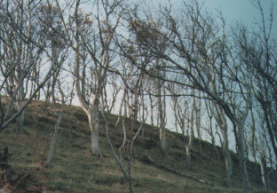
The hill where I saw the fox,
just south of Aberystwyth in mid-Wales
As I walked slowly down the slope,
I felt as if I - like Pwyll of the tale - had been led into the Otherworld.
Instead of hunting hounds, my guide had been a rich-red fox. There on a
windswept hill scattered with slender trees arching toward the morning
sky, the woods quiet with secrets, I was reminded of two lords of the Otherworld:
Arawn, the lord whose hounds led Pwyll into the Otherworld in pursuit of
a white stag. And of Sir Bertilak, who was also the Green Knight, from
the medieval English tale, Sir Gawain and the Green Knight. Both
Arawn and Sir Bertilak were masters of the forest and hunters. Both challenged
the honor and bravery of the hero. Surely Arawn and the Green Knight were
aspects of the same figure....Returning to town I began some research,
hoping to find out who this figure was. That's when I discovered the Green
Man, an archetype I've been fascinated with ever since.
In art and sculpture the Green Man
is a composite image - a face formed out of a mask of leaves, or a face
disgorging or devouring leaves and vines. He is an ancient figure, linked
with the Great Goddess as son, lover, and guardian. Whether as a 'foliate
head' carved in a European Gothic cathedral, or as a giant who tests the
hero, challenging him to impossible tasks, the Green Man is the intelligence
within the dark forest, in the tree of life. He represents irrepressible
life, renewal and rebirth, inspiration; he is the guardian and revealer
of the mysteries of Nature, and he is the union of humanity and the natural
world.
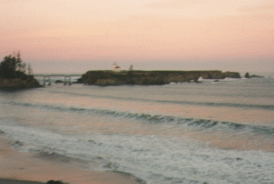
The pink of dawn is reflected
in the sea - near Coos Bay, Oregon
When my harp partner Deb Knodel and I first began to put
our duo music together, Deb was spending a sabbatical in a cottage overlooking
the sea on the Oregon coast. I, living, in Portland at the time, drove
down to practise. It was fall, and the colors were intense: deep blues
and greens of the trees and mountains, plush grays and whites of the clouds,
flaming red dogwood leaves, brilliant orange and yellow hand-sized maple
leaves patterning the roads, pearl-pink dawns.
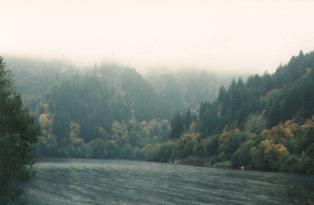
Deep blues and greens - a river
on the way to the Oregon coast
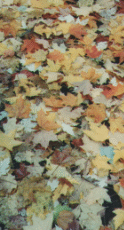
Maple leaves
Taking breaks we'd drive down to
Cape Arago, and hike amidst fir trees perched on a cliff. One tree in particular
caught our imagination. Fallen long ago, its roots and branches twined
around each other, seeming to sketch the outline of harps. That fall, with
new music all around us, of course we'd see harps in the trees. Our goal
in putting our music together was to say something new - to have fun with
our harps, to explore their sounds. The name we came up with for our duo
was Spookytree, after that magical harp-filled tree at Cape Arago.
A year later, we were recording our music at a studio in Sonoma County
amidst redwoods and the gold-turning-to-brown northern California hills.
What should we call our album? What was our concept? Deb and I didn't really
know. But the image we kept coming back to for our album cover was an antlered
leaf-face; the title, Masque.
I remember the night before recording
Redlands,
a piece I'd composed about my childhood summers in western Colorado. I
was very nervous about it. I had the textures and mood in mind, but I'd
never really been able to pull it together the way I wanted. But that night
a full moon poured light onto the woods, and as we drove to the farmhouse
where we were staying, a deer leaped across the road before us. It seemed
a good sign. In the predawn hours I a woke to a sound I'd never heard before:
a strange high-pitched barking. I realized what it was: a fox. I hadn't
encountered a fox since that walk years before in Wales. Moon, deer, and
fox; redwoods ranging the hills like guardians. I felt enveloped in myth.
Of course I'd be able to pull
Redlands together - and did. That
was also the morning Deb finally came up with the title for her piece:
Winter
Creek , after the farm where we were staying. It perfectly suited the
piece's thoughtfulness about quiet snow falling in the woods.
That's what recording our album
was like for us: living out magic. We could hardly believe that we were
doing something like this, something we'd never dreamed possible. And with
each passing day on the project the music became deeper, richer. Deb began
working on the Masque artwork, using her unique colored pencil techniques.
She used the antlered leaf-face, but bordered it with redwood leaves and
a Guatemalan scarf - bringing the Green Man across the ocean to California.
That's what we hoped we were doing with our music - blending motifs from
the two shores, having them dance together. She chose bold and luminous
colors: the oak leaf mask seemed bathed in the glowing and fiery light
of a dawn or twilight - impossible to say which. It was stunning - gorgeous
and powerful stuff. And like the music, it seemed bigger than we were.
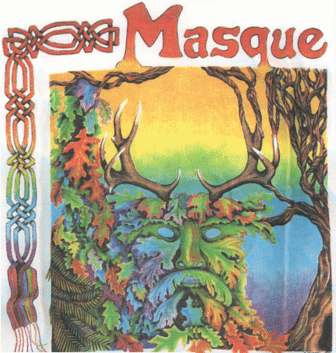
Deb's Masque artwork, copyright
1992.
So what happened to Spookytree and
Masque?
It's hard to say, really. Several people looked at the artwork, heard our
duo name and shook their heads. Marketing death, they said. Better to use
your own names, better to use a cover that doesn't encourage preconceptions
of your music that you may not mean. In the end, rightly or wrongly, we
agreed. We had become less comfortable with Spookytree as a duo name. And
though we loved the
Masque artwork and were still moved by it, we
thought maybe now wasn't the time. Maybe we could use it later, somewhere.
I think we just didn't understand how the leaf-mask - the Green Man - related
to harps and to the music we were playing. It was just like my experience
of searching for harps in Wales: I knew they were there. I just didn't
know where to find them.
2002 Note: In
1996 Deb & I featured the Green Man on our Forest
album, and in our Forest concert performances. Two years ago we reclaimed
Spookytree as our duo name. On this island of forest and magic, how could
we
not
use our name! Please visit our Spookytree
website!
end
 Beltane,
more commonly known these days as May Day, is a rambunctious celebration
if the virility and vitality of life. At this time of year, nature
is hell-bent on procreation. Even on a chilly overcast day like today
the air is scented with apple blossom. The pheasant who announces
his presence each morning in our field ("honk--honk" flap-flap-flap) is
quite dapper these days: red-brown feather coat at its brightest.
Last year we glimpsed him, his gray-brown missus, and their plain youngling
marching up our path to the forest. Why must the male always announces
his presence? Hardly a survival technique, but perhaps a territorial
one.
Beltane,
more commonly known these days as May Day, is a rambunctious celebration
if the virility and vitality of life. At this time of year, nature
is hell-bent on procreation. Even on a chilly overcast day like today
the air is scented with apple blossom. The pheasant who announces
his presence each morning in our field ("honk--honk" flap-flap-flap) is
quite dapper these days: red-brown feather coat at its brightest.
Last year we glimpsed him, his gray-brown missus, and their plain youngling
marching up our path to the forest. Why must the male always announces
his presence? Hardly a survival technique, but perhaps a territorial
one.







 Drop
a leaf into Jane's tip jar.
Drop
a leaf into Jane's tip jar.